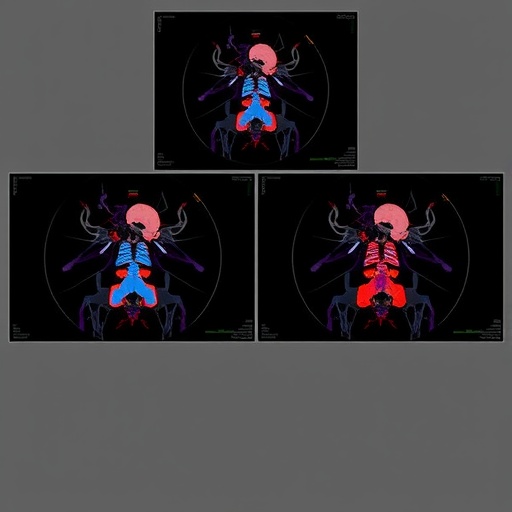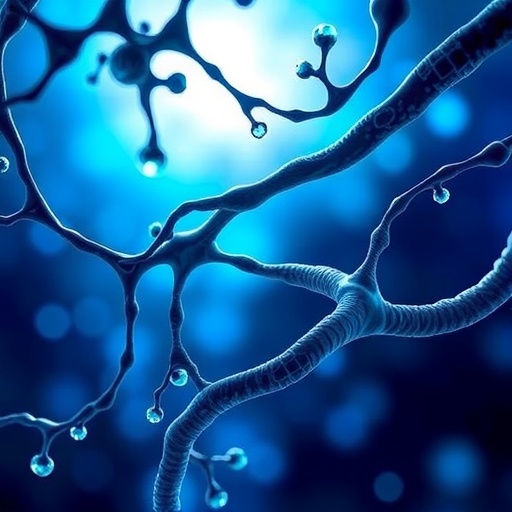In an era where artificial intelligence continues to revolutionize medicine, a groundbreaking development is reshaping the landscape of radiology. Researchers led by Wu, Zhang, and Zhang unveil a pioneering approach to constructing a generalist foundation model that seamlessly integrates both two-dimensional (2D) and three-dimensional (3D) medical imaging data on an unprecedented scale. This model is not merely another AI tool; it represents a paradigm shift toward unifying the fragmented world of radiological interpretation under the umbrella of a single, highly adaptable artificial intelligence framework. By harnessing web-scale datasets comprising millions of imaging studies, the team has crafted an algorithmic architecture that promises to exceed traditional diagnostic boundaries and herald a new era in medical imaging analysis.
Fundamental to their approach is the challenge of bridging the intrinsic differences between 2D and 3D imaging modalities. Conventional AI models typically specialize in either plane-based images such as chest X-rays or volumetric data like CT or MRI scans. However, real-world radiological practice demands versatility: clinicians interpret a mixture of both dimensional formats depending on the diagnostic scenario. The novel foundation model presented addresses this discord by adopting a multi-scale, multi-modal learning strategy capable of effectively ingesting and synthesizing diverse data types. This enables the AI system to understand and extract information regardless of dimensionality, providing a truly generalizable tool for radiologists across specialties.
Central to the success of this endeavor is the assembly of a vast web-scale dataset that includes more than ten million annotated imaging studies sourced from various institutions and regions worldwide. Data diversity is critical because medical images are influenced by equipment variability, patient demographics, and pathology spectrum. The team’s ability to collate such a heterogeneous assembly ensures that the model avoids overfitting to specific imaging conditions or patient populations. Moreover, rigorous preprocessing pipelines standardize the incoming data, enabling the model to focus on clinically relevant features rather than extraneous variations. This systematic global aggregation offers the foundation model an opportunity to learn universal radiological knowledge beyond localized nuances.
.adsslot_0D6bMWaukH{ width:728px !important; height:90px !important; }
@media (max-width:1199px) { .adsslot_0D6bMWaukH{ width:468px !important; height:60px !important; } }
@media (max-width:767px) { .adsslot_0D6bMWaukH{ width:320px !important; height:50px !important; } }
ADVERTISEMENT
The architecture designed by the researchers leverages cutting-edge transformer-based neural networks, which have revolutionized natural language processing and are now making formidable inroads into visual domains. Transformer models excel in capturing long-range dependencies and contextual information, a crucial trait for interpreting complex anatomical structures across multiple slices or planes. By extending transformer frameworks to embrace both 2D and 3D contexts, the foundation model comprehends not only local pixel-level anomalies but also broader spatial relationships that signify pathological or physiological patterns. This capacity for integrated spatial reasoning is poised to enhance diagnostic accuracy substantially and reduce false positives commonly encountered with conventional convolutional neural networks.
One of the most compelling aspects of this breakthrough is the model’s universal applicability, effectively erasing the traditional boundaries between specialized radiology subfields. Where AI has historically required separate models trained on dedicated datasets for chest, abdominal, neurological, or musculoskeletal imaging, this generalist foundation model excels across these domains without bespoke tuning. Such an advance minimizes the need for multiple development pipelines, streamlines clinical implementation, and fosters operational efficiency. In practice, a single AI tool can assist radiologists by providing preliminary diagnoses, highlighting regions of interest, or suggesting differential considerations regardless of the underlying imaging modality or anatomical site.
The system’s unsupervised and semi-supervised learning techniques are particularly noteworthy given the scarcity and cost of obtaining exhaustive expert annotations. While fully labeled medical datasets remain scarce due to privacy concerns and resource limitations, the model capitalizes on unannotated or partially annotated data by deriving implicit supervisory signals from the imaging structure itself. This approach enables expansive training on unlabeled datasets, therefore greatly amplifying the volume and variety of input information. Consequently, the ABI foundation model’s training regimen surpasses the scale and complexity of previous approaches, heralding a leap toward truly intelligent radiological AI.
In-depth evaluation of the model’s performance was conducted using multiple benchmark datasets and clinical challenge tasks. These assessments addressed not only diagnostic accuracy but also robustness against adversarial distortions, image artifacts, and variations stemming from different scanner vendors. Impressively, the generalist foundation model demonstrated consistent superiority over specialized AI counterparts, particularly in complex clinical scenarios involving subtle lesions or overlapping pathologies. Furthermore, the AI’s decision-making transparency was enhanced through integrated attention visualization mechanisms, allowing users to trace critical regions influencing the model’s predictions. This feature augments clinical interpretability and trust, which remain paramount for AI adoption in healthcare settings.
Beyond immediate clinical diagnostics, the implications of this research extend into the realms of medical education, research, and healthcare equity. By providing an accessible, universal AI tool capable of interpreting diverse imaging data, the model supports ongoing training for radiologists in underserved regions lacking subspecialty expertise. It also serves as a powerful means to accelerate medical research by rapidly characterizing large cohorts of images to identify novel disease biomarkers or subtle imaging phenotypes. Finally, the model’s ability to generalize across demographic and technological disparities could play a key role in reducing health inequities exacerbated by differential access to expert radiological opinions.
The engineering efforts behind this project involved meticulous attention to the computational infrastructure to support web-scale training. The model’s developers leveraged distributed computing frameworks running on high-performance GPUs and TPUs, enabling simultaneous processing of petabytes of imaging data. Innovative memory optimization and parallelism techniques allowed efficient training without compromising model fidelity or scope. Importantly, the researchers also emphasized reproducibility by open-sourcing their code, pre-trained weights, and curated datasets where permissible. This transparency fosters collaborative advancements and contributes to building a sustainable AI ecosystem in medical imaging.
Security and ethical considerations were deeply embedded in the project design. The team implemented rigorous de-identification protocols ensuring patient privacy was uncompromised during data aggregation. Additionally, they developed mechanisms to detect and mitigate algorithmic biases, a critical challenge given the model’s wide deployment potential. They advocate for continuous monitoring and feedback loops involving clinicians to ensure the AI’s outputs remain aligned with evolving medical standards and societal norms. Thus, the foundation model is envisioned not simply as a static artifact but as a living tool evolving alongside digital medicine.
The conceptual framework and technical achievements of this foundation model instigate fresh conversations about the future trajectory of AI-assisted healthcare. The unification of 2D and 3D data modalities under one learning paradigm marks a significant conceptual leap, undermining previous compartmentalized approaches. This research illustrates that large-scale, integrated AI systems can now transcend the limitations of narrowly scoped models, ushering in a new generation of tools that embody adaptability, scalability, and profound clinical relevance. The notion of “generalist” AI in medicine may soon extend beyond radiology to other specialties, stimulating innovative multimodal learning paradigms comprehensively integrating medical data sources.
As radiology stands on the cusp of this AI revolution, hospital systems and diagnostic centers face choices in deploying such foundation models. The integration into clinical workflows demands careful orchestration involving human-computer interaction design, validation across diverse populations, and regulatory endorsement. Experts anticipate that this technology will not supplant human radiologists but will instead augment their capabilities, automating routine interpretation tasks and freeing medical professionals to focus on complex diagnostic reasoning and patient care. In this cooperative model, AI acts as an indispensable partner, elevating efficiency and maintaining rigorous diagnostic standards.
Though the current model heralds success, the team acknowledges challenges ahead. Future directions include expanding data diversity further to encompass underrepresented patient cohorts and rare diseases. There is also interest in integrating temporal imaging data such as dynamic contrast-enhanced sequences or serial imaging to model disease progression. Additionally, bridging radiological findings with other clinical data such as genomics, pathology, and electronic health records will be critical for holistic patient modeling and personalized medicine applications. Hence, this foundation model is a seminal step within a broader roadmap toward intelligent, multimodal healthcare AI.
The impact of this study reverberates beyond academia and industry into global public health. Rapid, accurate, and scalable imaging interpretation reduces diagnostic delays critical in diseases such as cancer, cardiovascular disorders, and infectious diseases. Deployable in diverse clinical environments from high-resource urban hospitals to remote clinics, AI-powered tools democratize access to expert-level radiological insights. Especially in times of healthcare crises or pandemics, such adaptable AI infrastructure can serve as a frontline diagnostic augmentation, facilitating timely interventions and improving patient outcomes worldwide.
Ultimately, the research by Wu, Zhang, and colleagues constitutes a masterstroke in the ongoing journey to harness AI’s transformative potential in medicine. By demonstrating the feasibility and advantages of a unified foundation model built on the synergy of 2D and 3D imaging data, they set a new gold standard for radiological AI. The fusion of web-scale datasets, sophisticated transformer architectures, and robust evaluation frameworks illustrates a visionary synthesis of technology and clinical pragmatism. As this technology matures and integrates into practice, it promises to redefine radiology’s landscape, empower clinicians, and most importantly, enhance patient care on a global scale.
Subject of Research: Development of a generalist foundation model in radiology integrating web-scale 2D and 3D medical imaging data for enhanced diagnostic AI applications.
Article Title: Towards generalist foundation model for radiology by leveraging web-scale 2D&3D medical data.
Article References:
Wu, C., Zhang, X., Zhang, Y. et al. Towards generalist foundation model for radiology by leveraging web-scale 2D&3D medical data. Nat Commun 16, 7866 (2025). https://doi.org/10.1038/s41467-025-62385-7
Image Credits: AI Generated
Tags: 2D and 3D data integrationadvanced diagnostic algorithmsAI in medical imagingalgorithmic architecture in healthcareartificial intelligence in diagnosticsbridging 2D and 3D imaging challengesgeneralist radiology modelsmedical imaging analysis innovationmulti-modal learning in radiologyradiological interpretation unificationversatile AI for clinical practiceweb-scale datasets for healthcare





